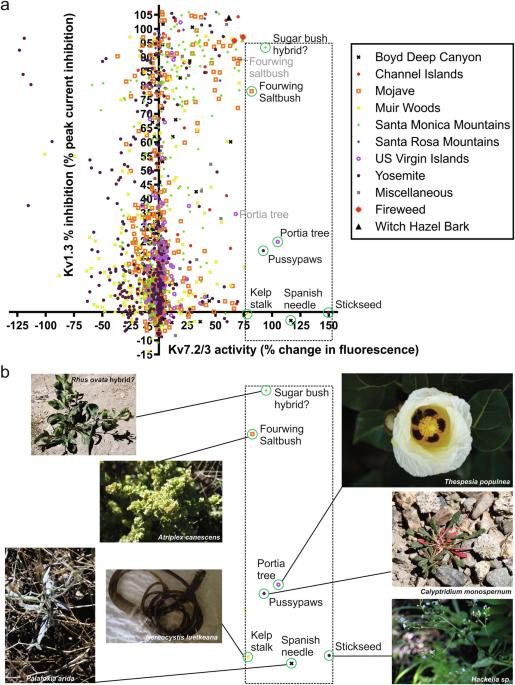Discovery of a potent, Kv7.3-selective potassium channel opener from a Polynesian traditional botanical anticonvulsant
IF 5.9
2区 化学
Q1 CHEMISTRY, MULTIDISCIPLINARY
引用次数: 0
Abstract
Plants remain an important source of biologically active small molecules with high therapeutic potential. The voltage-gated potassium (Kv) channel formed by Kv7.2/3 (KCNQ2/3) heteromers is a major target for anticonvulsant drug development. Here, we screened 1444 extracts primarily from plants collected in California and the US Virgin Islands, for their ability to activate Kv7.2/3 but not inhibit Kv1.3, to select against tannic acid being the active component. We validated the 7 strongest hits, identified Thespesia populnea (miro, milo, portia tree) as the most promising, then discovered its primary active metabolite to be gentisic acid (GA). GA highly potently activated Kv7.2/3 (EC50, 2.8 nM). GA is, uniquely to our knowledge, 100% selective for Kv7.3 versus other Kv7 homomers; it requires S5 residue Kv7.3-W265 for Kv7.2/3 activation, and it ameliorates pentylenetetrazole-induced seizures in mice. Structure-activity studies revealed that the FDA-approved vasoprotective drug calcium dobesilate, a GA analog, is a previously unrecognized Kv7.2/3 channel opener. Also an active aspirin metabolite, GA provides a molecular rationale for the use of T. populnea as an anticonvulsant in Polynesian indigenous medicine and presents novel pharmacological prospects for potent, isoform-selective, therapeutic Kv7 channel activation. The voltage-gated potassium (Kv) channel formed by Kv7.2/3 heteromers is a major target for anticonvulsant drug development, however, specificity and potency are key challenges for Kv7.2/3 opener development. Here, the authors report the discovery of gentisic acid as a potent and selective Kv7.3 opener from Thespesia populnea — a plant reportedly used as an anticonvulsant in Polynesian traditional medicine.

从一种波利尼西亚传统植物抗惊厥剂中发现一种强效的 Kv7.3 选择性钾通道开启剂。
植物仍然是具有高治疗潜力的生物活性小分子的重要来源。由 Kv7.2/3(KCNQ2/3)异构体形成的电压门控钾(Kv)通道是抗惊厥药物开发的主要目标。在此,我们筛选了 1444 种主要从加利福尼亚州和美属维尔京群岛采集的植物中提取的提取物,以确定它们是否能激活 Kv7.2/3,而不能抑制 Kv1.3,从而避免单宁酸成为活性成分。我们验证了 7 个最有希望的结果,确定了 Thespesia populnea(黍、稷、茯苓树)最有希望,然后发现它的主要活性代谢产物是龙葵酸(GA)。GA 能强效激活 Kv7.2/3(EC50,2.8 nM)。据我们所知,GA对Kv7.3和其他Kv7同源物具有100%的选择性;它需要S5残基Kv7.3-W265才能激活Kv7.2/3,并能改善戊四唑诱导的小鼠癫痫发作。结构-活性研究显示,美国食品和药物管理局批准的血管保护药物多贝斯酸钙(一种 GA 类似物)是一种以前未曾认识到的 Kv7.2/3 通道开启剂。GA 也是一种活性阿司匹林代谢物,它为波利尼西亚土著医药中使用白头翁作为抗惊厥药提供了分子理论依据,并为强效、同种异构选择性、治疗性 Kv7 通道激活提供了新的药理学前景。
本文章由计算机程序翻译,如有差异,请以英文原文为准。
求助全文
约1分钟内获得全文
求助全文
来源期刊

Communications Chemistry
Chemistry-General Chemistry
CiteScore
7.70
自引率
1.70%
发文量
146
审稿时长
13 weeks
期刊介绍:
Communications Chemistry is an open access journal from Nature Research publishing high-quality research, reviews and commentary in all areas of the chemical sciences. Research papers published by the journal represent significant advances bringing new chemical insight to a specialized area of research. We also aim to provide a community forum for issues of importance to all chemists, regardless of sub-discipline.
 求助内容:
求助内容: 应助结果提醒方式:
应助结果提醒方式:


